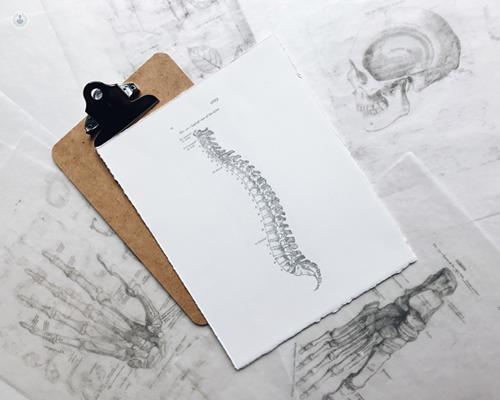What is spinal stenosis?
Escrito por:Leading consultant neurosurgeon and spinal surgeon Mr Jonathan Bull discusses spinal stenosis including symptoms, treatment and diagnosis, in this informative article.

What is spinal stenosis?
Spinal stenosis is typically where the spinal canal is and the nerve roots in the spinal cord are located, get progressively more narrow, partly due to degeneration over the course of time. The disc will start to bulge out into the canal, and in addition to that, you'll get thickening of the ligaments that hold the different vertebral bodies together. As they thicken up, the canal gets progressively tighter and tighter.
This is a normal process that most people see over the course of time, and to some extent, largely unavoidable. For a lot of people, it won't make any difference at all and it will never manifest with any symptoms. For a small subset of people, it can manifest as progressively shortening the distance they can walk.
So, what will happen is that, for example, they'll walk from their home to a local shop, to the bus stop, or a regular commute to work, and what they'll find is the distance they can walk starts to become shorter and shorter. What they tend to find is that their legs feel quite heavy or numb; they may get some pain. Typically, it isn't the same kind of pain you get with sciatica, such as a shooting, sharp pain, but it's more like a gradual increase in discomfort and stiffness.
What patients will then find is that, they'll probably want to sit down and find themselves walking leaning forward. When you lean forward, because of the point of which you pivot in your spine, is sort of in the middle of the vertebral body or in the vertebral body rather than the canal, which sits behind it. As you lean forward, it opens up the space that the nerves have because it opens the canal space up. Then, what they'll do is, they'll rest and they'll be able to walk the same distance again. What they have is what's called a claudication distance. It's a reliable distance they can walk before the symptoms start, and then they'll have to stop.
The reason for that is, as you do more activity, the blood supply that supplies the nerves increases, but because the canal is so tight, the pressure from the blood vessels is insufficient and in effect they become ischaemic which manifests as pain and numbness in your legs. You sit and you rest, then the blood demand drops off, and you walk about the same distance again.
With that, some people will also describe, for example: if people do their shopping in a supermarket, if you find that you lean forward and push your shopping trolley, it's easier to do your shopping than when you're standing upright.
The way to differentiate from vascular claudication with a problem with the blood vessels in your legs, for example, is that when you tend to walk uphill with vascular claudication, you feel physically quite tired because the blood supply is insufficient and you find that more difficult. With spinal claudication, or spinal stenosis, people often complain that when they walk downhill it's more of a problem because as you lean backwards it makes the spine canal even tighter and the claudication difference theoretically gets shorter.
What are the symptoms of spinal stenosis?
The symptoms can be quite subtle, but commonly they're a progressive reduction in your walking distance secondary to usually:
- pain;
- numbness, and;
- heaviness in your legs.
What are the causes of spinal stenosis?
Basically, the typical cause is the course of time. Sometimes, you'll get it from other causes, like rare things that might cause those sorts of symptoms, like you may get a growth of a tumour within the spinal canal. Things like a growth of a tumour within the vertebral bodies, but typically that manifests more with back pain rather than leg pain, and stiffness and heaviness.
How is spinal stenosis diagnosed?
Usually, a patient history is taken and it normally it will be quite convincing. You may have a normal examination in the lower limbs, and then in addition, an MRI machine is the most common way you'll see stenosis in the spinal canal. To add, you'll often see the stenosis on an MRI scan in patients who are completely asymptomatic.
How is spinal stenosis treated?
You can manage it, potentially with physiotherapy exercises. Typically, the usual treatment will be surgical decompression, what's called laminectomy. It can be done with a relatively small incision and the removal of the area in the bone that's causing that degree of narrowing. It tends to be something that you see, perhaps in an older population because it often takes a longer time to become established. The third type of treatment is usually more straightforward; typically, as a lumbar laminectomy or lumbar decompression operation.
What are the complications of spinal stenosis surgery?
You don't necessarily have to treat spinal stenosis, and sometimes people have other medical problems that mean it isn't suitable to treat it.
It does progressively get narrower so the walking distance will get shorter and shorter, and people will find significant limitation in their mobility.
When it's treated surgically, it's at the end of the more straightforward operations that we do. The common complications, like any operations, are:
- infection,
- bleeding, and;
- problems with wound healing.
Sometimes, there's risk in terms of damage to the nerve roots. So, you can have permanent weakness, bladder, bowel or sexual dysfunction. The risk of those is very small. It's probably much less than one per cent. Sometimes you have leakage of fluid around the nerve roots and that means the patient will have to stay in bed for a couple of days to allow that to heal. The fluid can leak out, so what you have to do is lie flat to reduce the pressure on the closed wound.
Typically, it's an operation that's successful. You say it's to stop the person getting worse, but quite frequently people get a lot better. Their mobility and walking distance will get a lot longer. Usually, it involves a relatively short hospital stay, sometimes 24 or 48 hours depending on your other medical problems.
If you're concerned about spinal stenosis and are considering treatment, arrange a consultation with Mr Bull via his Top Doctors profile.


